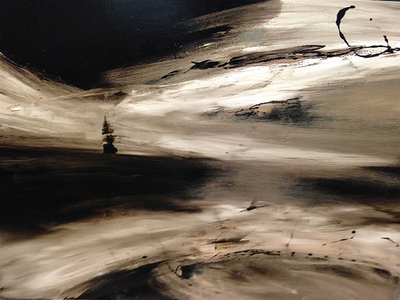Christopher Volpe: Loomings

Christopher Volpe, T’Gallant Sails, 2016, oil and tar on canvas, 36 x 48″. Image courtesy of the artist.
Christopher Volpe’s paintings are stark conduits of the inherent oppositions between human beings and the natural world. Loomings, Volpe’s title for the exhibition, is also the title of the first chapter of Herman Melville’s Moby-Dick, which explored the American dilemma of controlling nature for the sake of industrial development while also being at odds with nature’s power. In the novel, ship’s Captain Ahab’s ambitions for commercial reward transform to a personal obsession for revenge and dominance of the white whale that in an earlier encounter had taken his leg.
Volpe, who writes for this magazine, has created paintings that are inspired by, but do not serve as, illustrations of the novel. Volpe, responding to Melville’s text as a painter, reverses his practice of his own art writing about other painters.
The paintings are darkly romantic, recalling the gestural power of artists J. M. W. Turner, Albert Pinkham Ryder and Franz Kline. Volpe’s work stands on its own, but he has ancestors. All painters connect to the painting tribe and Volpe celebrates certain traditions. Add writer Melville to Ryder, and you get a hint of Volpe’s DNA. Volpe’s limited palette includes black and white oils and tar, blending in moody amber and brown inflections. Some paintings include bits of gold leaf that flicker and activate the atmosphere. Reading at first like abstractions, the paintings reveal their pictorialism.
Last Light nearly eliminates representation in pursuit of a meditation on nightfall and the threat that it harbors. Modest in size, Volpe’s paintings do not surround the viewer, but they enable, even insist upon, a deliberate aiming into their somber layers. Volpe’s images evoke silence even as they suggest storms at sea. Paintings like Never Dream and Horizon Sails set ships onto roiling oceans. They reveal the painter’s moving, loaded brush as kin to the moving swells. Navigation is about direction and the perils of losing it. T’Gallant Sails puts us on board; its sweeps of white against tarry spaces confuse where we are going—east or west? Both at once? There is no certainty in a slashing wind and less security.
